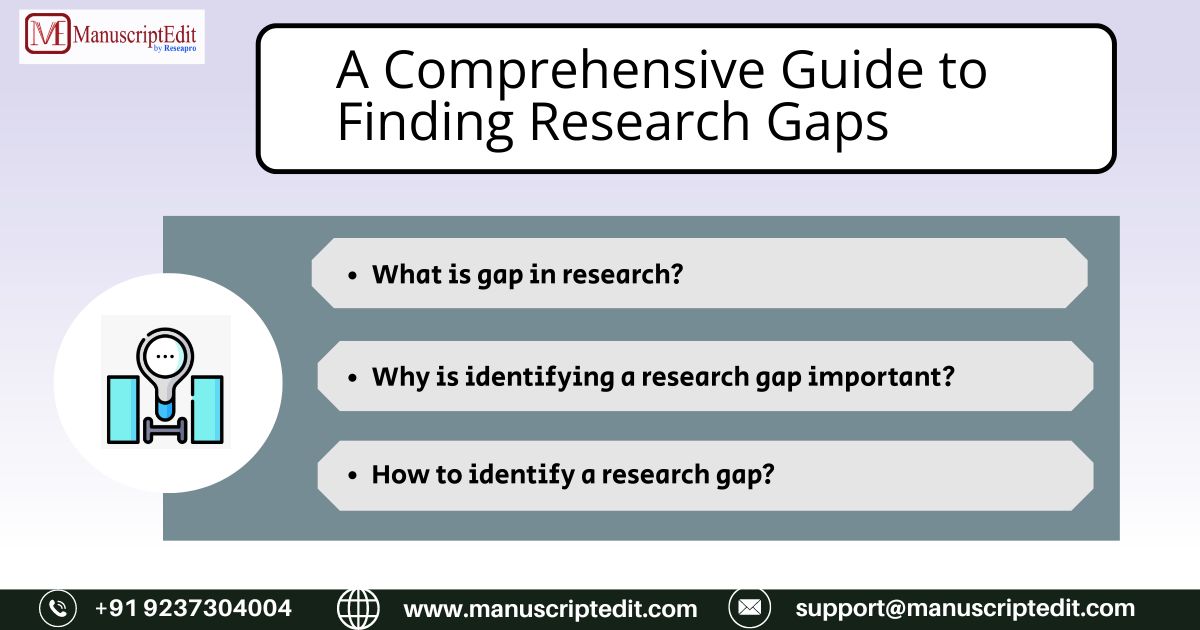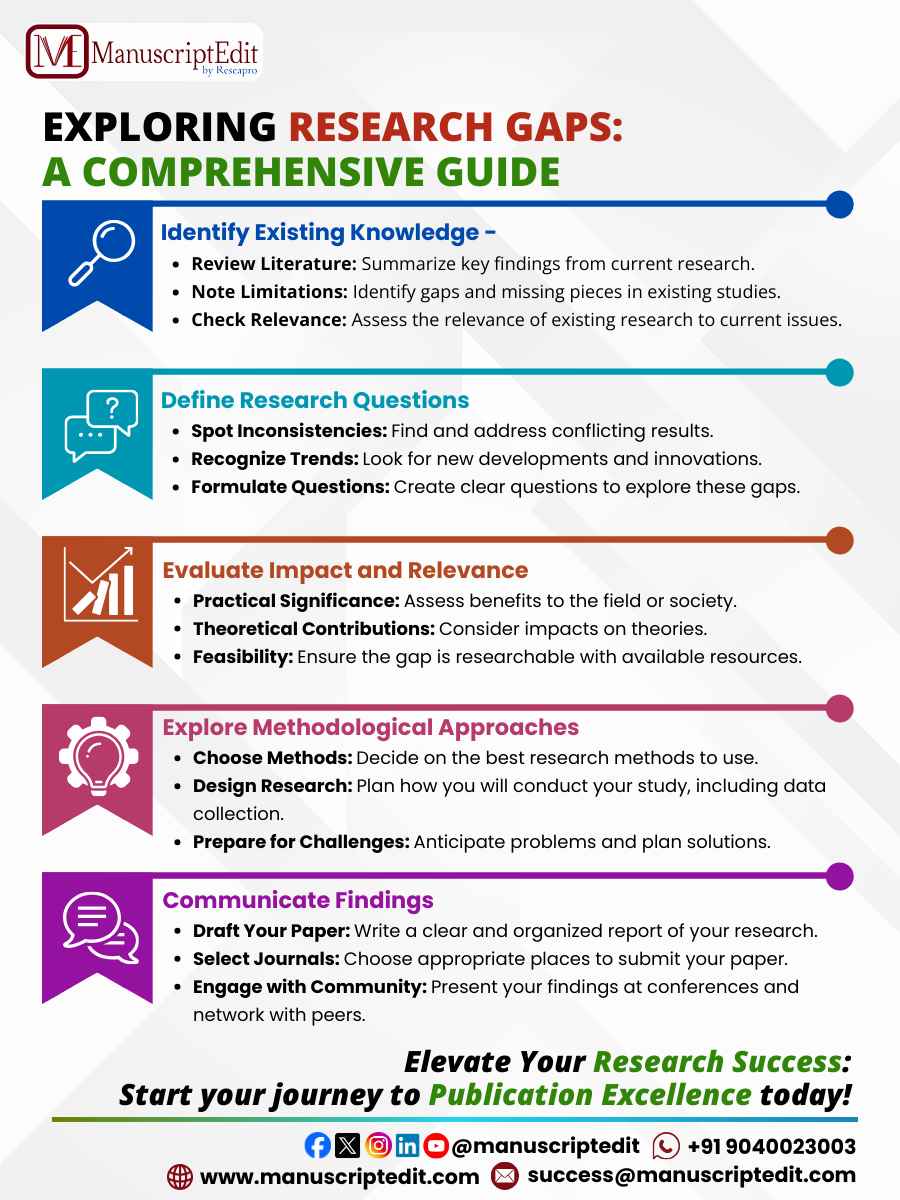|
Getting your Trinity Audio player ready...
|

If academics and researchers wish to make a fresh contribution to their subject, they must first identify a research gap. Finding an undiscovered trail in a forest can led to fascinating discoveries, answers, or fresh perspectives.
Let us examine what constitutes a research gap, and why identifying one can enhance the significance of your work.
A Research Gap: What Is It?
Areas or issues in a field that have not been thoroughly investigated or where there is a lack of current knowledge are referred to as research gaps. Consider it as the last puzzle piece that needs to be put in place. These gaps may manifest as unresolved issues, contradictory conclusions, or regions in need of more research. Why It is so Important to Find Research Gaps Identifying a research gap enables you to focus your efforts on producing fresh discoveries. In any field, filling in these gaps can result in ground breaking discoveries, inventiveness and progress. Research that closes a gap in the literature also has a tendency to have a greater influence and be of greater value to scholars.
Methods for Finding Research Gaps Although identifying research gaps might be challenging, it can be made simpler by following these guidelines.
Step 1: Extensive Reading in Your Field Begin by thoroughly reading the literature that has already been written about your subject. Examine scholarly publications, articles, and research.
Look for recurring themes, and note areas where questions remain unanswered. Gaps often reveal themselves as you read and compare what has already been researched.
Step 2: Ask Yourself Questions
While reading, engage with the content critically. Are there any ideas that seem unclear or inadequately addressed? What’s missing? These questions can lead you directly to potential gaps that require further research.
Step 3: Stay Updated on New Developments
Research is constantly evolving. Keeping an eye on the latest studies, trends and technological advancements can highlight fresh questions that have yet to be answered. Following updates ensures you are aware of new gaps emerging from the latest
Step 4: Speak with Subject Matter Experts.
Talk to professors, senior researchers, and other authorities in your field. Experienced academics frequently have knowledge of possible research gaps and areas that are currently understudied. Talking with others who have been there before might provide insightful viewpoints and help you identify any gaps.
Step 5: Use Research Tools to Track Trends
Leverage academic databases and research tools to track trends in your field. Google Scholar, for example, can help you monitor what’s being talked about. By tracking which areas are gaining attention, you can pinpoint less-explored topics.
Types of Research Gaps
There are various kinds of research gaps that can emerge in any field. Here are the most common ones:
Knowledge Gaps
These occur when there’s a lack of information or understanding in a certain area. For example, we may know some facts about a disease but not fully understand why it behaves in certain ways.
Conceptual Gaps
These happen when existing theories or models don’t explain new observations. It might require a new theoretical framework or a fresh approach to fill the gap.
Methodological Gaps
In some cases, current research methods are inadequate or outdated. New problems may arise against that need improved or entirely different research methods.
Data Omissions:
Sometimes there is insufficient information to make trustworthy decisions, or the information that is available may be disorganized or incomplete.
Useful Omissions: These are the areas lacking the application of research findings to practical situations. Something that functions well in the laboratory, for instance, might not transition well to real-world circumstances.
Examples of Research Gaps:
To make things clearer, here is some examples of research gaps:
Illustrations of Research Gaps:
To help clarify, the following are some instances of research gaps: Inadequate Knowledge of the Mechanisms of Disease Even when scientists are aware of how a disease impacts individuals, there may still be a lack of knowledge regarding the biological processes underlying it.
Incongruous Study Findings: Results from various studies on the same subject can occasionally differ. In order to reconcile the contradictory results, this disagreement may point to a gap that requires further investigation.
Research on New Technologies
Research gaps can appear as technology advances. For example, contemporary medical approaches like AI-driven diagnostics may still have large gaps in their knowledge, even though older techniques
may have been well explored.
Methods for Filling a Literature Gap:
Finding a solution for a gap is the next step once it has been discovered.
Conduct your own Research to Fill existing Gaps and contribute New Insights:
Consider creating your own study or experiment to collect data and fill in the gaps if you have identified any. Work Together with Other Researchers Working together with other academics enables you to pool resources, knowledge, and viewpoints, which facilitates filling up bigger or more intricate gaps. Examine the Current Literature Looking back at previous studies might occasionally provide important new information or point out areas that want updating. Looking back at earlier research could assist you in identifying holes that were missed.
Instruments for Identifying Research Gaps:
Google Scholar is one helpful resource to assist you in your hunt for research gaps. A vital resource for locating scholarly articles and observing current trends in your area of expertise. PubMed is particularly helpful for tracking studies, reviews, and current research in the biological sciences and medical fields. ResearchGate a website that allows researchers to connect with experts in their field, exchange their findings, and work together. It is a fantastic forum for queries and answers. Tools for Bibliographic Management Finding and analyzing pertinent research are made easier with the use of tools like Endnote or Zotero, which help you manage your references and monitor sources.
Conclusion:
Finding research gaps is crucial to the advancement of any discipline. By concentrating on areas that need further inquiry, it enables researchers to produce fresh ideas and discoveries. You can identify these gaps and contribute significantly to your profession by using the tools at your disposal and the above-described processes.




